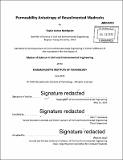Permeability anisotropy of resedimented mudrocks
Author(s)
Nordquist, Taylor James
DownloadFull printable version (31.80Mb)
Other Contributors
Massachusetts Institute of Technology. Department of Civil and Environmental Engineering.
Advisor
John T. Germaine.
Terms of use
Metadata
Show full item recordAbstract
Permeability anisotropy (ratio of horizontal to vertical permeability) is an important but uncertain parameter used in characterizing underground formations. While it is a fairly unknown parameter, it is integral for the petroleum industry, where a greater permeability anisotropy understanding can greatly aid in basin modelling, pore pressure prediction, and borehole stability. This research experimentally characterizes the permeability anisotropy of several mudrocks, which are clay-rich sedimentary formations, using re-sedimentation, a process of homogenization of naturally-occurring soils and recreation of the sedimentation environment in a controlled laboratory setting. The permeability anisotropy of resedimented Boston Blue Clay (RBBC), an illitic lean clay (CL), increases from 1.5 to 3 when mechanically compressed from 0.1 to 40 MPa, corresponding to porosities ranging from 0.55 to 0.26. Resedimented Gulf of Mexico - Eugene Island mudrock (RGoM-EI), a smectitic fat clay (CH), exhibits permeability anisotropy increasing from 1 to 5 when compressed to the same stresses, corresponding to porosities ranging from 0.6 to 0.25. Not only does smectitic RGoM-EI mudrock transition to greater anisotropy with compression, but the rate of increase accelerates with compression. These measurements are made using a commercially-available Trautwein® constant rate of strain (CRS) consolidometer with vertical drainage combined with a novel radially-outward draining CRS device. The combination of the vertically and radially draining CRS devices produces permeability anisotropy data quickly, with very little scatter. For RGoM-EI, the effects of horizontal shearing to 29.5% shear strain at 0.14 MPa on permeability anisotropy are negligible. Permeability anisotropy of the homogeneous resedimented mudrocks tested, using a cubic specimen constant head permeameter within a triaxial cell, is directly correlated to their electrical conductivity anisotropy. The permeability anisotropy values measured using this technology, however, are lower than those measured using CRS testing.
Description
Thesis: S.M., Massachusetts Institute of Technology, Department of Civil and Environmental Engineering, 2015. Cataloged from PDF version of thesis. Includes bibliographical references (pages 257-260).
Date issued
2015Department
Massachusetts Institute of Technology. Department of Civil and Environmental EngineeringPublisher
Massachusetts Institute of Technology
Keywords
Civil and Environmental Engineering.